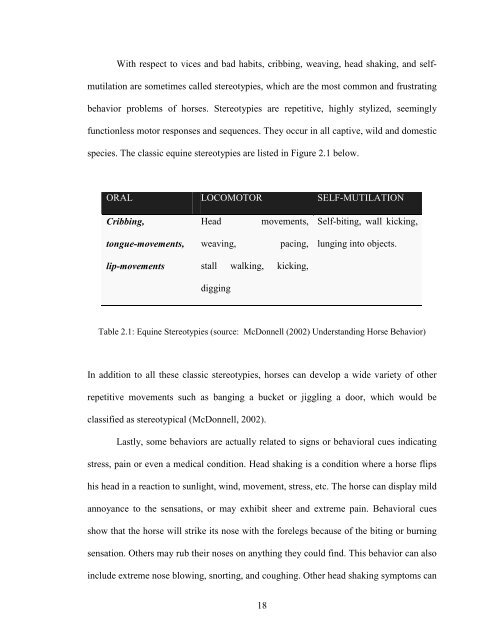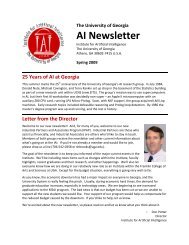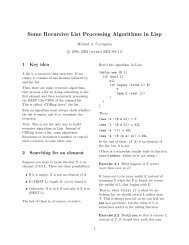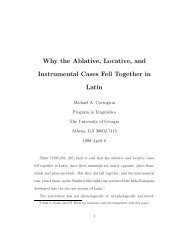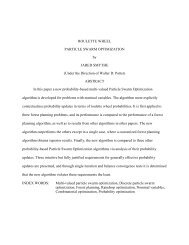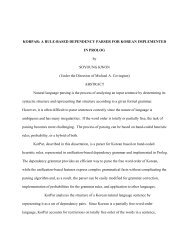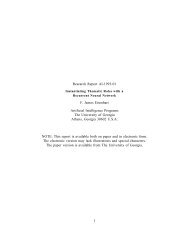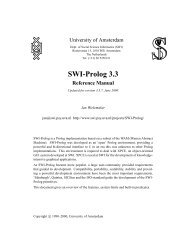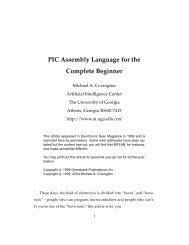human judgment in diagnosing problem behavior in horses using
human judgment in diagnosing problem behavior in horses using
human judgment in diagnosing problem behavior in horses using
Create successful ePaper yourself
Turn your PDF publications into a flip-book with our unique Google optimized e-Paper software.
With respect to vices and bad habits, cribb<strong>in</strong>g, weav<strong>in</strong>g, head shak<strong>in</strong>g, and selfmutilation<br />
are sometimes called stereotypies, which are the most common and frustrat<strong>in</strong>g<br />
<strong>behavior</strong> <strong>problem</strong>s of <strong>horses</strong>. Stereotypies are repetitive, highly stylized, seem<strong>in</strong>gly<br />
functionless motor responses and sequences. They occur <strong>in</strong> all captive, wild and domestic<br />
species. The classic equ<strong>in</strong>e stereotypies are listed <strong>in</strong> Figure 2.1 below.<br />
ORAL LOCOMOTOR SELF-MUTILATION<br />
Cribb<strong>in</strong>g,<br />
Head<br />
movements,<br />
Self-bit<strong>in</strong>g, wall kick<strong>in</strong>g,<br />
tongue-movements,<br />
weav<strong>in</strong>g,<br />
pac<strong>in</strong>g,<br />
lung<strong>in</strong>g <strong>in</strong>to objects.<br />
lip-movements<br />
stall walk<strong>in</strong>g, kick<strong>in</strong>g,<br />
digg<strong>in</strong>g<br />
Table 2.1: Equ<strong>in</strong>e Stereotypies (source: McDonnell (2002) Understand<strong>in</strong>g Horse Behavior)<br />
In addition to all these classic stereotypies, <strong>horses</strong> can develop a wide variety of other<br />
repetitive movements such as bang<strong>in</strong>g a bucket or jiggl<strong>in</strong>g a door, which would be<br />
classified as stereotypical (McDonnell, 2002).<br />
Lastly, some <strong>behavior</strong>s are actually related to signs or <strong>behavior</strong>al cues <strong>in</strong>dicat<strong>in</strong>g<br />
stress, pa<strong>in</strong> or even a medical condition. Head shak<strong>in</strong>g is a condition where a horse flips<br />
his head <strong>in</strong> a reaction to sunlight, w<strong>in</strong>d, movement, stress, etc. The horse can display mild<br />
annoyance to the sensations, or may exhibit sheer and extreme pa<strong>in</strong>. Behavioral cues<br />
show that the horse will strike its nose with the forelegs because of the bit<strong>in</strong>g or burn<strong>in</strong>g<br />
sensation. Others may rub their noses on anyth<strong>in</strong>g they could f<strong>in</strong>d. This <strong>behavior</strong> can also<br />
<strong>in</strong>clude extreme nose blow<strong>in</strong>g, snort<strong>in</strong>g, and cough<strong>in</strong>g. Other head shak<strong>in</strong>g symptoms can<br />
18


